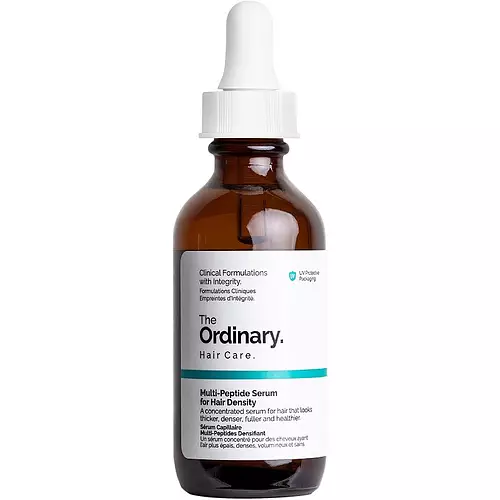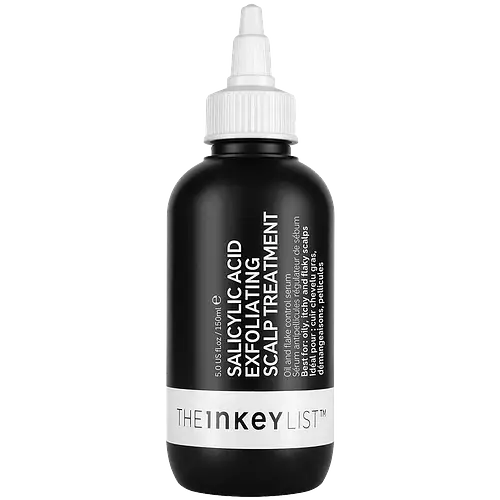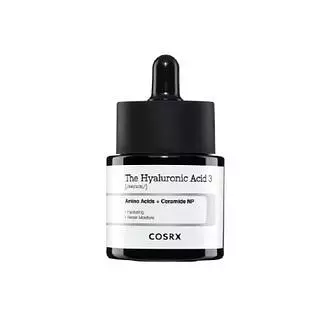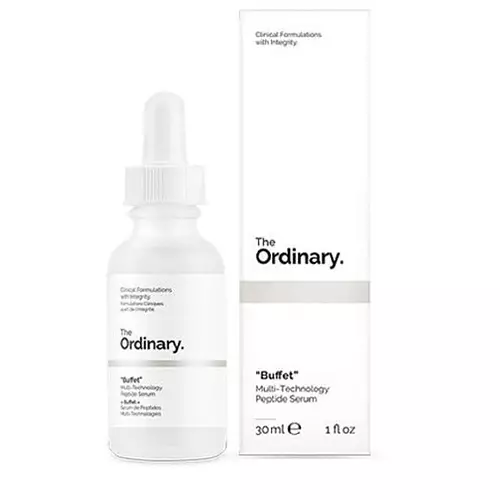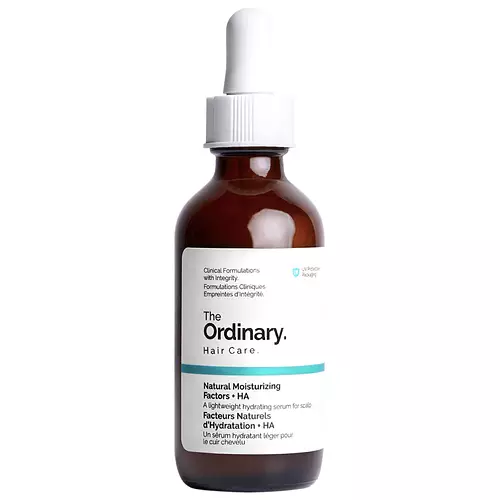
The Ordinary Natural Moisturizing Factors + HA for Scalp Ingredients Explained
Overview
What it is
Serum with 36 ingredients that contains AHA
Cool Features
It is vegan, cruelty-free, and reef safe
Suited For
It has ingredients that are good for fighting acne, anti aging, dry skin, brightening skin, reducing pores, scar healing, dark spots and better texture
Free From
It doesn't contain any harsh alcohols, common allergens, fragrances, oils, parabens, silicones or sulfates
Fun facts
The Ordinary is from Canada. This product is used in 4 routines created by our community.
We independently verify ingredients and our claims are backed by peer-reviewed research. Does this product need an update? Let us know.
Serum with 36 ingredients that contains AHA
Quick info
You should know
Notable Ingredients
This product contains 1 ingredient that may have this attribute:
Benefits
This product contains 3 ingredients that may have this attribute:
This product contains 2 ingredients that may have this attribute:
This product contains 1 ingredient that may have this attribute:
This product contains 1 ingredient that may have this attribute:
This product contains 1 ingredient that may have this attribute:
This product contains 2 ingredients that may have this attribute:
This product contains 1 ingredient that may have this attribute:
This product contains 1 ingredient that may have this attribute:
Concerns
This product contains 2 ingredients that may have this attribute:
This product contains 2 ingredients that may have this attribute:
This product contains 2 ingredients that may have this attribute:
Ingredients 36
Water. It's the most common cosmetic ingredient of all. You'll usually see it at the top of ingredient lists, meaning that it makes up the largest part of the product.
Squalane is an emollient that helps the skin hold onto moisture. It's an oily liquid that occurs naturally in certain types of fish and plant oils.
We don't have a description for C12-13 Alkyl Glyceryl Hydrolyzed Hyaluronate.
Arginine is an amino acid that is important for human development. Your body uses is it to produce hair keratin and skin collagen.
Aspartic Acid is an amino acid that our bodies produce naturally. It is an antioxidant.
Glycine is an amino acid that helps build proteins. It is already present in our skin as our bodies produce them naturally.
Serine is an amino acid naturally found in our body. Our bodies use amino acids to create protein.
Proline is an amino-acid. It helps moisturize the skin and plays an important role in creating proteins.
Threonine is an amino-acid. It helps hydrate the skin and has antioxidant benefits.
Phenylalanine is an amino acid. It is a skin soothing and hydrating ingredient. Amino acids play a crucial role in wound healing and skin hydration.
Glutamic Acid is an amino acid that is found in all living organisms. Our bodies use this to help nerve cells in the brain communicate with other cells.
Glucose is a simple sugar and is the most important source of energy in all organisms. In skincare, glucose is used to hydrate the skin. It also acts as a prebiotic for our natural biome.
Sucrose is a natural sugar found in fruits, vegetables, and nuts. It is the main constituent of white sugar.
Sodium PCA is the sodium salt of pyroglutamic acid and is naturally occurring on human skin.
Zinc PCA (or "zinc salt") differs slightly from zinc itself. PCA stands for pyrrolidone carboxylic acid. However, Zinc PCA comes from zinc.
This ingredient is the magnesium salt of PCA (Pyrrolidone Carboxylic Acid). It is a great skin hydrator for the top layers of skin.
Urea is also called carbamide and is the diamide of carbonic acid. In cosmetics, urea is used to hydrate the skin. It also provides exfoliation in higher concentrations.
Sodium Lactate is the sodium salt of lactic acid, an AHA. It is a humectant and used to adjust the pH of a product.
Lactic Acid is an AHA that is derived from fermenting lactose, a carbohydrate from milk. It removes the top layer of old and dead skin cells and helps increase cell turnover.
Lauryl Glucoside sugar- and lipid-based cleansing agent. It is created from glucose and lauryl alcohol.
Isoceteth-20 comes from Isocetyl Alcohol. It is an emulsifier. Emulsifiers help stabilize a product. It does this by preventing certain ingredients from separating.
Dextrin is used to thicken a product and helps bind ingredients together. It is created from starch and glycogen.
Hexylene Glycol is a surfactant. Glycols are a class of alcohols. Hexylene Glycol is a surfactant and emulsifier.
Potassium Sorbate is a preservative used to prevent yeast and mold in products. It is commonly found in both cosmetic and food products.
Phenoxyethanol is a preservative that has germicide, antimicrobial, and aromatic properties. Studies show that phenoxyethanol can prevent germ and microbial growth. By itself, it has a scent that is similar to that of a rose.
Chlorphenesin is a synthetic preservative. It helps protect a product against bacteria in order to extend shelf life. In most cases, Chlorphenesin is paired with other preservatives such as phenoxyethanol and caprylyl glycol.
Water, Squalane, C12-13 Alkyl Glyceryl Hydrolyzed Hyaluronate, Arginine, Aspartic Acid, Glycine, Alanine, Serine, Valine, Isoleucine, Proline, Threonine, Histidine, Phenylalanine, Glutamic Acid, Glucose, Fructose, Sucrose, PCA, Sodium PCA, Zinc PCA, Magnesium PCA, Manganese PCA, Urea, Sodium Lactate, Lactic Acid, Hexyl Nicotinate, Lauryl Glucoside, Myristyl Glucoside, Polyglyceryl-6 Laurate, Isoceteth-20, Dextrin, Hexylene Glycol, Potassium Sorbate, Phenoxyethanol, Chlorphenesin
Ingredient Ratings
Based on the number of likes and dislikes each ingredient has received.
Ingredients Explained
Water. It's the most common cosmetic ingredient of all. You'll usually see it at the top of ingredient lists, meaning that it makes up the largest part of the product.
So why is it so popular? Water most often acts as a solvent - this means that it helps dissolve other ingredients into the formulation.
You'll also recognize water as that liquid we all need to stay alive. Talk about multi-purpose! If you see this, drink a glass of water. Stay hydrated!
Learn more about WaterSqualane is an emollient that helps the skin hold onto moisture. It's an oily liquid that occurs naturally in certain types of fish and plant oils.
Because squalane boosts hydration in the skin, it also comes with plenty of benefits: it is an antioxidant and can help fight free radicals and skin damage. Squalane is also found to have a detoxifying effect when applied.
Squalane comes from squalene, which occurs naturally within the sebum of our skin. It is one of the oils our skin produces to keep itself hydrated. Squalane is the hydrogenated version of squalene and has a longer shelf life.
Research shows that squalane is non-irritating (even at 100% concentration).
In general, it's a fantastic ingredient. It does a great job at hydrating the skin, and it's suitable for those with sensitive skin.
The source of squalane may impact malassezia / fungal acne. This is because olive oil derived squalane can contain impurities such as fatty acids and plant waxes. Sugarcane derived squalane is recommended for anyone with malassezia concerns.
Is squalane vegan?
This depends on the source. Squalane can be derived from both plants and animals. Most squalane used in skincare comes from plants.
Please note: the source of squalane is only known if disclosed by the brand. We recommend reaching out to the brand if you have any questions about their squalane.
Read more about squalene with an "e".
Learn more about SqualaneWe don't have a description for C12-13 Alkyl Glyceryl Hydrolyzed Hyaluronate.
Arginine is an amino acid that is important for human development. Your body uses is it to produce hair keratin and skin collagen.
As a cosmetic ingredient, Arginine has antioxidant properties and can also help repair damaged skin. This ingredient is derived either synthetically or from animals.
Arginine isn't fungal acne safe when used in the presence of other lipids (fats, fatty acids, oils, esters, etc). Oils and fats occur naturally within the skin, so take caution when using Arginine if you're prone to fungal acne.
Learn more about ArginineAspartic Acid is an amino acid that our bodies produce naturally. It is an antioxidant.
Our body uses Aspartic Acid to help build collagen and elastin. It also plays a role in hydrating skin.
Antioxidants help mitigate damage from free-radical molecules. These are molecules that originate from external sources such as pollution, cigarette smoke, or the sun.
Learn more about Aspartic AcidGlycine is an amino acid that helps build proteins. It is already present in our skin as our bodies produce them naturally.
Glycine helps keep skin hydrated and reduce signs of aging. Amino acids help transport moisture throughout our skin; glycine already plays a role in helping keep our skin moisturized.
As collagen is made up of glycine and other amino acids, it is believed Glycine may help our skin produce more collagen. Collagen helps keep skin plump and firm.
Learn more about GlycineAlanine is an amino acid and is already found in the human body.
Alanine has antioxidant properties and can help with anti-aging.
Alanine is used by fibrous proteins such as collagen, elastin, and keratin. These three help make a strong skin barrier. Having a healthy skin barrier leads to more plump and youthful skin.
Learn more about AlanineSerine is an amino acid naturally found in our body. Our bodies use amino acids to create protein.
Amino-acids help give keep our skin hydrated. They play an important role in the skin barrier, which keeps the skin plump and firm.
Serine is a non-essential amino acid, meaning we don't need to obtain it from eating foods.
Learn more about SerineWe don't have a description for Valine.
We don't have a description for Isoleucine.
Proline is an amino-acid. It helps moisturize the skin and plays an important role in creating proteins.
Proline is one of the building blocks for producing collagen. As we age, our bodies produce less collagen. Collagen helps the skin look plump and firm.
In medicine, proline is used as an osmoprotectant. This means it helps prevent oxidative degradation in other drugs.
Our bodies are able to produce proline naturally, but certain conditions may inhibit this production. In that case, proline can be obtained from eating egg whites, soy protein, dairy products, asparagus, mushrooms, and seaweed.
Learn more about ProlineThreonine is an amino-acid. It helps hydrate the skin and has antioxidant benefits.
Threonine is vital for creating collagen and elastin. Collagen and elastin support youthful and firm skin. Our bodies decrease collagen production naturally with age.
Humans are not able to create threonine and must get it through eating foods such as fish, lentils, poultry, sesame seeds, and more.
Learn more about ThreonineWe don't have a description for Histidine.
Phenylalanine is an amino acid. It is a skin soothing and hydrating ingredient. Amino acids play a crucial role in wound healing and skin hydration.
Phenylalanine is also used to help even out skin tone due to its ability to disrupt the melanin production process.
Two structures of phenylalanine exist: L-phenylalanine and D-phenylalanine. L-phenylalanine is essential, this means our bodies cannot produce it naturally and we must get it from foods. Our bodies convert D-phenylalanine to neurotransmitters, and D-phenylalanine is found in our bodies naturally.
Some foods that contain L-phenylalanine include eggs, soybeans, beef, milk.
Learn more about PhenylalanineGlutamic Acid is an amino acid that is found in all living organisms. Our bodies use this to help nerve cells in the brain communicate with other cells.
In cosmetics, glutamic acid is a famous humectant. It draws water from the air to your skin, keeping your skin hydrated (like hyaluronic acid).
An in-vitro study from 2024 found glutamic acid to play a role in inhibiting inflammation and thus a potential skin-soothing ingredient.
Other studies show it to be have potential wound healing, skin barrier repair, and hair growth properties.
Glutamic acid has poor solubility in water and other solvents.
Learn more about Glutamic AcidGlucose is a simple sugar and is the most important source of energy in all organisms. In skincare, glucose is used to hydrate the skin. It also acts as a prebiotic for our natural biome.
As a humectant, glucose draws moisture from the air and from deeper levels in the skin. This helps hydrate skin.
Our skin's natural microbiome contains many saccharides that act as prebiotics. These prebiotics help strengthen our skin's microbiome. Having a healthy microbiome helps protect our skin from harmful bacteria and other contaminants.
Studies show glucose may help with fading discoloration and pigmentation. This is because our skin metabolizes glucose into lactic acid. Lactic acid is an AHA that helps exfoliate the top layer of skin.
Plants and algae make glucose during the process of photosynthesis. It is then used to make cellulose, the building blocks of cell walls.
Learn more about GlucoseSucrose is a natural sugar found in fruits, vegetables, and nuts. It is the main constituent of white sugar.
In skincare, sucrose is a humectant and can be a mild exfoliant.
Sucrose is hydrophilic, meaning it attracts water. This makes it an effective humectant and helps hydrate the skin.
Studies show sugars may worsen acne-prone skin due to it disrupting the skin's natural biome. We recommend speaking with a professional if you have any concerns.
In some products such as body scrubs, sucrose is used as an gentle exfoliant.
The term 'sucrose' comes from the french word for sugar, 'sucre'.
Learn more about SucrosePCA is derived from amino acids and is naturally found in our skin's barrier.
As a humectant, PCA helps draw and hold moisture to the skin. Studies show it is effective at helping the skin stay hydrated long-term.
Sodium PCA is the sodium salt of pyroglutamic acid and is naturally occurring on human skin.
The PCA stands for pyrrolidone carboxylic acid, a natural amino acid derivative.
Sodium PCA is a has conditioning, anti-inflammatory, and humectant properties. Humectants help hydrate your skin by drawing moisture from the air. This helps keep your skin moisturized.
Learn more about Sodium PCAZinc PCA (or "zinc salt") differs slightly from zinc itself. PCA stands for pyrrolidone carboxylic acid. However, Zinc PCA comes from zinc.
It can help reduce redness, regulate sebum, and promote the general healing process of the skin.
Zinc PCA tends to be especially useful for those with oily, acne-prone skin. It's certainly an ingredient worth trying out!
Learn more about Zinc PCAThis ingredient is the magnesium salt of PCA (Pyrrolidone Carboxylic Acid). It is a great skin hydrator for the top layers of skin.
PCA is a natural humectant, meaning it draws water from the air to your outer layer of skin.
One study found magnesium ions improved skin hydration in the outer layer of skin, or the stratum corneum. However, it did not improve TEWL, or the transepidermal water loss. The TEWL is an indicator of how healthy your skin barrier function is. This study primarily looked at healthy skin with intact skin barrier.
Learn more about Magnesium PCAWe don't have a description for Manganese PCA.
Urea is also called carbamide and is the diamide of carbonic acid. In cosmetics, urea is used to hydrate the skin. It also provides exfoliation in higher concentrations.
As a humectant, urea helps draw moisture from the air and from deep within the skin. This helps hydrate your skin. Studies show urea is an effective moisturizer for dry skin conditions. 40% urea is typical in medications for treating eczema and other skin conditions.
Urea has the strongest exfoliation effect in concentrations higher than 10%. It is a keratolytic agent, meaning it breaks down the keratin protein in the top layer of skin. This helps remove dead skin cells and flaking skin.
In medicine, urea has been shown to help increase the potency of other ingredients, such as fungal treatments.
Humans and animals use urea to metabolize nitrogen-containing compounds. Urea is highly soluble in water. Once dissolved, it is neither acidic nor alkaline.
Learn more about UreaSodium Lactate is the sodium salt of lactic acid, an AHA. It is a humectant and used to adjust the pH of a product.
Sodium Lactate is part of our skin's NMF, or natural moisturizing factor. Our NMF is essential for the hydration of our top skin layers and plasticity of skin.
It also influences our skin's natural acid mantle and pH, which protects our skin from harmful bacteria.
Our NMF is formed from amino acids, lactic acid, sugars, minerals, peptides, and electrolytes. As we age, our NMF naturally depletes. Other sources of NMF depletion include harsh and drying ingredients such as denatured alcohol. Sodium lactate can help replenish our NMF, leading to more hydrated and plump skin.
High percentages of Sodium Lactate can have an exfoliating effect.
Sodium Lactate is produced from fermented sugar.
Learn more about Sodium LactateLactic Acid is an AHA that is derived from fermenting lactose, a carbohydrate from milk. It removes the top layer of old and dead skin cells and helps increase cell turnover.
Benefits of Lactic Acid are that it can help to reduce large pores and reduce the effects of aging. Some potential downsides are that it can be bad for dry skin, cause irritation, worsen eczema, and worsen rosacea.
Not only does it help exfoliate the skin, it helps strengthen the skin's barrier. When applied, lactic acid helps the skin create ceramides.
Lactic acid is an over-the-counter chemical exfoliant that comes from the fermentation of lactose — a carbohydrate found in milk.
Legend has it that Cleopatra used to bathe in sour milk to help reduce wrinkles.
Read more about some other popular AHA's here:
Learn more about Lactic AcidWe don't have a description for Hexyl Nicotinate.
Lauryl Glucoside sugar- and lipid-based cleansing agent. It is created from glucose and lauryl alcohol.
Lauryl Glucoside makes it easier to rinse oil, dirt, and other polluants away.
A British study found lauryl glucoside to cause skin sensitivity for some people. We recommend speaking with a professional if you have concerns.
Learn more about Lauryl GlucosideWe don't have a description for Myristyl Glucoside.
Polyglyceryl-6 Laurate isn't fungal acne safe.
Isoceteth-20 comes from Isocetyl Alcohol. It is an emulsifier. Emulsifiers help stabilize a product. It does this by preventing certain ingredients from separating.
Dextrin is used to thicken a product and helps bind ingredients together. It is created from starch and glycogen.
As an emulsifier, dextrin prevents ingredients from separating. This helps elongate a product's shelf life.
Studies show coating UV filters with dextrin prevents these ingredients from being absorbed. This helps UV ingredients last longer on the skin.
Learn more about DextrinHexylene Glycol is a surfactant. Glycols are a class of alcohols. Hexylene Glycol is a surfactant and emulsifier.
As a surfactant, Hexylene Glycol helps gather dirt and oil on your skin to be washed away.
As an emulsifier, Hexylene Glycol helps keep water and oil together. This prevents them from separating in a product. Hexylene Glycol also thins out the texture of a product by lessening viscosity.
Hexylene Glycol has a small molecular weight.
Learn more about Hexylene GlycolPotassium Sorbate is a preservative used to prevent yeast and mold in products. It is commonly found in both cosmetic and food products.
Potassium sorbate is potassium salt derived from sorbic acid. Sorbic acid is a natural antibiotic and effective against fungus.
Potassium sorbate and sorbic acid can be found in baked goods, cheeses, dried meats, dried fruit, ice cream, pickles, wine, yogurt, and more.
Potassium sorbate is often used with stronger preservatives.
Learn more about Potassium SorbatePhenoxyethanol is a preservative that has germicide, antimicrobial, and aromatic properties. Studies show that phenoxyethanol can prevent germ and microbial growth. By itself, it has a scent that is similar to that of a rose.
It's often used in formulations along with Caprylyl Glycol to preserve the shelf life of products.
Chlorphenesin is a synthetic preservative. It helps protect a product against bacteria in order to extend shelf life. In most cases, Chlorphenesin is paired with other preservatives such as phenoxyethanol and caprylyl glycol.
Chlorphenesin is a biocide. This means it is able to help fight the microorganisms on our skin. It is also able to fight odor-releasing bacteria.
Chlorphenesin is soluble in both water and glycerin.
Studies show Chlorphenesin is easily absorbed by our skin. You should speak with a skincare professional if you have concerns about using Chlorphenesin.
Learn more about ChlorphenesinWhen to use
How this product is used by our community
Reviews
Yoshikage_Kira04
Excellent For Dry Scalp
For someone who has had a dry scalp condition since birth, this product works extremely well. I put it on at nighttime and...
Excellent For Dry Scalp
For someone who has had a dry scalp condition since birth, this product works extremely well. I put it on at nighttime and when I wake up, my scalp has far less flakes than it had last night. I do this daily and there has been a huge reduction in itching, redness and flakiness.
Just don't put this on your face, since it causes fungal acne.
CaroleD
Absolutely terrible for me, personally.
It must feed the type of fungus I have on my scalp because it made my dandruff sooo much worse, like...
Absolutely terrible for me, personally.
It must feed the type of fungus I have on my scalp because it made my dandruff sooo much worse, like huge flakes formed overnight.
I possibly have fungal acne, so if you have it I would definitely avoid it. Coconut oil does the same thing to me.
Compared With
Here are some products that it's often compared with
More The Ordinary Products
See all The Ordinary productsMore Serums
See all serumsWe're dedicated to providing you with the most up-to-date and science-backed ingredient info out there.
The data we've presented on this page has been verified by a member of the SkinSort Team.
Read more about us




